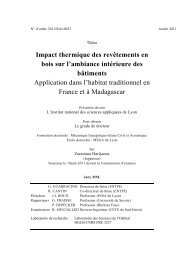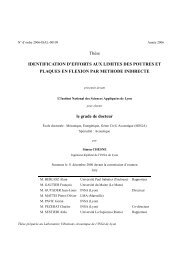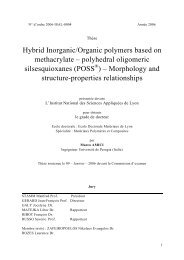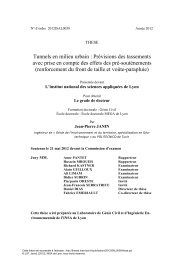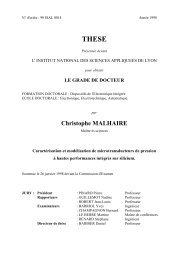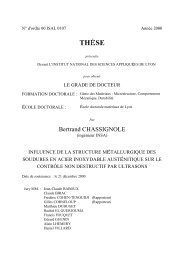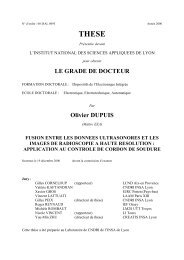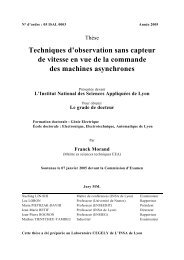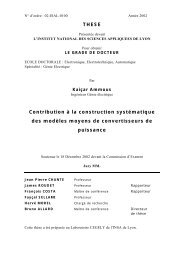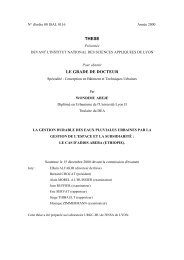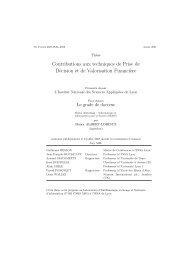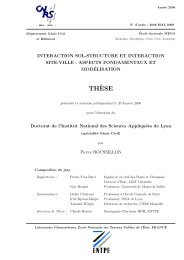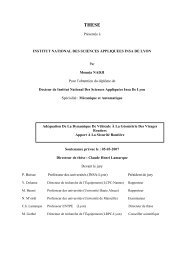Rhéologie aux interfaces des matériaux polymères multicouches et ...
Rhéologie aux interfaces des matériaux polymères multicouches et ...
Rhéologie aux interfaces des matériaux polymères multicouches et ...
Create successful ePaper yourself
Turn your PDF publications into a flip-book with our unique Google optimized e-Paper software.
Rheology at the Interface of Multilayer polymers: Application to the<br />
Coextrusion Process<br />
Abstract<br />
Coextrusion technologies are commonly used to produce multilayered composite she<strong>et</strong>s or films with a large<br />
range of applications from food packaging to optics. The contrast of rheological properties b<strong>et</strong>ween layers can<br />
lead to interfacial instabilities during flow. Important theor<strong>et</strong>ical and experimental advances have been made<br />
during the last deca<strong>des</strong> on the stability of compatible and incompatible polymers using a mechanical approach.<br />
However, few works were dedicated to the physicochemical affinity b<strong>et</strong>ween the neighboring layers. The present<br />
study deals with the influence of this affinity on interfacial instabilities for functionalized incompatible polymers.<br />
Polyamide (PA6)/Poly<strong>et</strong>hylene‐grafted with glycidyl m<strong>et</strong>hacrylate (GMA) was used as a reactive system and<br />
PE/PA6 as a non reactive one. Two gra<strong>des</strong> of polyamide (PA6) were used in order to enable us to change the<br />
viscosity and elasticity ratios b<strong>et</strong>ween PE (or PE‐GMA) and PA6. We have experimentally confirmed, in this case,<br />
that the weak disturbance can be predicted by considering an interphase of non‐zero thickness (corresponding to<br />
interdiffusion/reaction zone) instead of a purely geom<strong>et</strong>rical interface b<strong>et</strong>ween the two reactive layers.<br />
As a first step, a generic study was led to obtain a b<strong>et</strong>ter handle of this process with reactive multilayered<br />
materials. Rheological behavior of multilayer coextruded of cast films was investigated to probe: (i) the<br />
comp<strong>et</strong>ition b<strong>et</strong>ween polymer/polymer interdiffusion and interfacial reaction of functionalized polymer and (ii)<br />
the influence of various param<strong>et</strong>ers in relationship with the process: temperatures, contact time, shear rate and<br />
residence time… The contribution of interface/interphase effect has been studied along with the increase of the<br />
number of layers. The results show that the variation in dynamic modulus of the multilayer system reflects both<br />
diffusion and chemical reaction. The results were rationalized by comparing the obtained data with some existing<br />
theor<strong>et</strong>ical models. Finally, and in order to quantify the contribution of the effect of the interface/interphase with<br />
a specific interfacial area, an expression was developed to take into account the interphase triggered b<strong>et</strong>ween the<br />
neighbouring layers and allowed us to estimate its thickness at a specific welding time and shear rate.<br />
As the second step, we formulate an experimental strategy to optimize the process by listing the different<br />
param<strong>et</strong>ers controlling the stability of the reactive multilayer flows. The plastic films of two, three and five layers<br />
were coextruded in symm<strong>et</strong>rical and asymm<strong>et</strong>rical configurations in which PA6 is a middle layer. Indeed, for<br />
reactive multilayered system, the interfacial flow instability can be reduced or eliminated, for example, by (i)<br />
increasing the residence time or temperature in the coextrusion bloc (for T over reaction temperature) and (ii)<br />
reducing the total extrusion flow rate. Furthermore, the role of viscosity ratio, elasticity ratio, and layer depth of<br />
the stability of the interface were also investigated coupling to the physicochemical affinity. Hence, based on this<br />
analysis guide‐lines for stable coextrusion of reactive functionalized polymers can be provided.<br />
Keywords: Rheology ‐ Interdiffusion – coextrusion‐ interfacial reaction ‐ Multilayer polymers – interphaseinterfacial<br />
instabilities.



